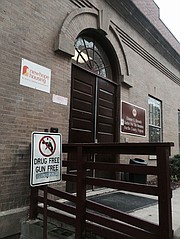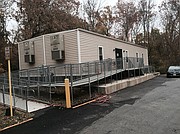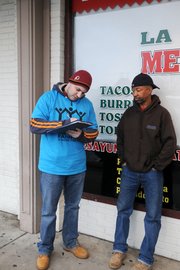Encampments like this were found scattered around the Lorton area, usually near major shopping areas, but sometimes in isolated fields. Not all encampments had tents for people to sleep; volunteers often found old couches and sleeping bags, or temporary shelters made of cardboard, plastic and scrap pieces of wood. Photo by Robbie Hammer.
Details
Find out more at http://www.fairfaxc…">www.fairfaxcounty.g…
Jameel Mubaarik of Reston is a 63-year-old Army veteran and mechanical engineer, a former Reston homeowner. He served in the Army in Europe during the Cold War, and among many positions since, worked for Bechtel on the Silver Line and for NASA at the Goddard Space Center.
But a layoff, divorce and a short-sale on his home left Mubaarik homeless, for a time living in a hotel.
Then last May he had a stroke.
“I never thought I would be homeless, but you never know,” he said.
Vincent Jenkins, director of the Embry Rucker Shelter in Reston calls Mubaarik “the Historian,” for his recall of Northern Virginia events, and professorial narrative.
Mubaarik is ready to move out of the homeless shelter and into housing, and as part of a national effort to end veteran homelessness, he’ll be looking at possible apartments next week.
In December 2014, Fairfax County joined the Mayors Challenge to End Veteran Homelessness, a nationwide effort with a tight deadline — the end of this year. In Fairfax County, it’s an effort that will in all likelihood be successful.
“At the end of the calendar year, will we have functionally ended veteran homelessness in Fairfax County?” said Tom Barnett, program manager with the Fairfax County Office to Prevent and End Homelessness. While some veterans here will still experience housing crisis, there will be systems in place designed to get them into housing quickly.
Functionally ending veteran homelessness, according to the Mayors Challenge, means that every community has a sustainable, systematic response in place that ensures homelessness is prevented whenever possible, or is otherwise a rare, brief, and non-recurring experience. That’s the mantra for ending and preventing homeless for all: Homelessness should be rare, brief and non-recurring.
Veterans made up 46 of the 1,204 people who were homeless on Jan. 28, 2015 in the 2015 Point-in-Time Count of People Experiencing Homelessness. A dozen to 15 veterans become homeless every month, but because of ongoing collaboration, most are “rapidly rehoused.” While 96 veterans came into hypothermia shelters last winter season, at the end of October, Barnet reported that there were 17 homeless veterans in the county, and that all 17 were in the process of being housed.
“We owe something to veterans. to the people who have made that sacrifice for us,” said Sharon Bulova, chairman of the Fairfax County Board of Supervisors, who signed onto the Mayors Challenge. She notes that the sacrifice veterans make is measures in time, and in uncertainty.
“When you look at the issue of veterans, the sacrifice is spending time away from the community and from their families,” she said. “With that time away comes the potential for coming back changed; that could be physically changed and harmed, and some of the harm might not be physical. Psychological changes might not be visible. We can’t turn our backs on people who have been affected that way.”
Of the 46 veterans identified in the Point in Time count in January, 15 were chronically homeless. Housing people who have been chronically homeless is not a quick transition; it requires supportive housing and ongoing services. Someone is identified as chronically homeless if they have been continuously homeless for a year or more and have experienced three or more episodes of homelessness in the last four years, a sequence of events that often comes with untreated illnesses, mental health issues and/or substance abuse.
A task force consisting of representatives from nonprofits like FACETS, New Hope Housing, Northern Virginia Family Service and Cornerstones, plus the Office to Prevent and End Homelessness, the Department of Veterans Affairs, the Community Service Board, the health department and other partners has been meeting every other week since the county joined the challenge. At the meetings, the partners discuss the individual veterans they are seeking to house by name, and focus attention and resources on overcoming challenges.
“At the task force meetings, we celebrated a lot this year. Each time we met, there were another four to five veterans who were housed.”
— Vincent Jenkins, director, Embry Rucker Shelter, Reston
“At the task force meetings, we celebrated a lot this year,” said Vincent Jenkins of Cornerstones, director of the Embry Rucker Shelter in Reston. “Each time we met, there were another four to five veterans who were housed. … Fairfax plays really well together. We are really trying to make a major dent in homelessness, and we are doing that.”
The “tremendously impactful” tool of choice is the VASH voucher, said Barnett. The Veterans Affairs Supportive Housing program combines rental assistance for homeless veterans with case management and clinical services provided by the Department of Veterans Affairs. Once a veteran has been approved for a housing voucher and gets into housing, Veterans Affairs deploys a team to help with transition from the shelter to housing, one of the benefits of the nationwide challenge.
The effort to end homelessness for veterans comes with a different level of community support, too.
“In the community, there is so much energy and interest to end homelessness for veterans who have served our country,” said Dean Kline, director of the Office to Prevent and End Homelessness. Partners and community groups are engaged “because of their passion for helping veterans who have served our country.”
NOT ALL VETERANS who are experiencing homelessness are ready to accept housing, but ongoing outreach by local nonprofits ensures continuing progress. Sometimes it takes years simply to identify that someone is a veteran if that individual is resistant to sharing information.
One man now in line for housing hovered for eight years at the Eleanor Kennedy Shelter on Richmond Highway by Fort Belvoir. While he would seem pleasant, when anyone tried to engage him or ask questions, he became verbally aggressive and expressed anti-government sentiments, said Tonya Golden, director of Programs for Single Adults at New Hope Housing. He was part of the overflow shelter program, operated in a trailer outside the main building, coming for food and shelter.
“He was resistant to service,” Golden said. “We never knew he was a veteran.”
But with ongoing efforts, the man, now “up in age,” developed a rapport with one outreach person, and agreed to sign up for housing. As they filled out the information needed, he made reference to his service. New Hope Housing submitted his name to Veterans Affairs, discovering that he served 14 years including in Vietnam, was honorably discharged and entitled to benefits.
Now he’s qualified for a VASH voucher, is working with housing case managers and will move into an apartment with supportive services soon.
Most veterans who arrive at a shelter do not have the critical documentation they need.
New Hope Housing opened Veterans House, a home with case management services for four veterans, where the veteran doesn’t have to sign a lease.
“We take veterans who have challenges leasing up, so it’s in our name,” Golden said. “These are the clients that we work with, they are ready to move forward. … There’s no judgment.”
Clients who have criminal records or other issues that might prevent them from being approved for a lease still need housing.
Golden is a military spouse, her husband is career army, a lieutenant colonel. They lived for a time on Fort Belvoir. “We’ve been doing this for a long time,” she said. “It’s personal for me that our soldiers are connected to the services they are entitled to.”
THE DAILY ROUTINE for Richard Davis, a veteran and a single dad: Davis sleeps at the Eleanor Kennedy Shelter for the Homeless on Richmond Highway by Fort Belvoir, while his two young children sleep at a nearby friend’s house. In the morning, Davis gets his children ready for the day, drives his son, 4, to a program that addresses the son’s intellectual disabilities and then Davis cares for his daughter, 2, who has health issues. He picks his son up in the afternoon, and later, after he gets his children dinner and puts them to bed, he heads back to the shelter to sleep.
At least that was the routine until last Thursday, when New Hope Housing was able to place him in permanent supportive housing with three bedrooms for him and his two children.
Davis served in the Navy. Then he served 25 years in prison, and was released in 2008.
“With a 25-year gap, no one is going to give you the kind of job you need to take care of yourself,” Davis said. He worked three jobs at one time, but still didn’t earn enough to support his family. And now the full time care of his children presents other challenges.
Davis trained as a paralegal in prison. “I have five habeas corpus briefs under my belt,” he said. But when he applied for jobs at law firms when he was released, his prison record kept him from employment.
Davis speaks in a deep voice that reflects the sense that he expected more of himself. He describes himself as “disheartened” by his lack of accomplishment since being released in 2008. He’s educated and well-spoken, It’s clear that his children bring him joy, and that now getting this part right means the world to him.
“You know you have aspirations when you’re younger. You have goals. And you’re not really achieving them. I’m dealing with my mortality now,” he said. “I have 10-11 more years. I’m living for my children. It’s my responsibility to turn out good human beings. … I want them to be able to go to Dad and to know they will answer to Dad. They are the love of my life.”
“In my heart, I feel like I have a lot to give,” Davis said.
“In my heart, I feel like I have a lot to give.”
— Richard Davis, single dad, was living at the Kennedy Shelter by Fort Belvoir
NOT ALL VETERANS in need of housing are men.
One woman veteran who had served in the Army for three years, emerged struggling with mental illness. She stopped taking her medication, and got into trouble with law. She was receiving services from Northern Virginia Family Services, and was one of the homeless veterans discussed by name at the task force meetings, said Barbara Schultheiss, program director of Services for Single Adults at FACETS in Fairfax.
“So many people just need help with a security deposit and a few months rent,” Schultheiss said. “But some need more support.”
“So many people just need help with a security deposit and a few months rent. But some need more support.”
— Barbara Schultheiss, FACETS
FACETS operates permanent supportive housing, and when a vacancy opened up there, Schultheiss coordinated her move into a new apartment.
“She’s very independent, and she loves her apartment,” Schultheiss said. But she also talks about Vladimir Putin as her husband, and dances around her living room with his photo. In her new home, she’ll get case management services to help keep her in housing.
There is evidence of long-term success, too.
One Navy veteran lived 17 years in the woods, and has now lived in FACETS housing for seven years with support after serving in the Navy with awards.
“He comes with his own slew of medical problems,” said Schultheiss, who was his case manager in 2008, and helped track down his service record.
He told her, “If it wasn’t for the FACETS program I’d be dead.”
Schultheiss asked him why he left the Navy. “Being on a ship with a bunch of guys, it just got old,” he said.
But after that, he couldn’t get a job that would pay the bills.
VETERANS WHO HAVE recently been in service have been in an environment where they have had one important job, protecting the country, and their basic needs like housing, food, schedule and health, have been cared for in a very structured way, said Barnett. “They find themselves on the street without any of that. They’ve had a job to focus on, but now they have to worry about how to take care of themselves,” he said, and their frustration in the new circumstances can be extreme.
Veterans can also be among the most vulnerable of people experiencing homelessness, chronically homeless and living in the woods.
“Their basic training has prepared them to be out there, to withstand some things that most people cannot,” said Vincent Jenkins of Cornerstones of challenges of even getting some veterans who have lived outdoor for a long time into the shelter. “It’s not always a good fit for them here in the shelter.”
Reaching out to the most vulnerable homeless is helped in part by work done in 2013 when nonprofit volunteers, county employees and others went out into the woods and other areas, creating an inventory and conducting interviews. Fairfax County participated in the national 100,000 Homes campaign, ranking chronically homeless people on the vulnerability index that indicates who is a greatest risk of death. Of more 462 people surveyed, 10 percent were veterans.
Veterans who have lived outside for an extended period are also more likely to be resistant to services.
At the Embry Rucker Shelter, staff uses the “BOLO” protocol as part of their outreach efforts. That’s “be on the lookout.” They know which veterans they need to reach, and when one of them comes in the door for a bagged lunch or anything else, outreach staff is alerted so someone can come to interact.
While Vietnam-era vets who are homeless are more likely to be among those that are extra resistant to coming indoors, their advancing age sometimes makes them more willing. Homeless veterans of any of the Gulf Wars are more likely to be dealing with PTSD, but also are more likely to be able to jump right back into housing after a crisis with some financial help, said several homeless advocates.
“Their symptoms are related to the trauma they experienced in war,” said Greg White, chief operating officer at Cornerstones. “Their coping mechanisms include alcohol, substance abuse. ...
“One guy who had been living out in the woods told me about the adjustment he had to make to living in a house,” White said. Sometimes people who have moved into housing still come back to the shelter, or even the woods, to visit. “Those social connections mean a lot to them.”
Outreach during the very cold months when chronically homeless are more likely to come to the shelters, and also the Health Care for the Homeless programs offer opportunities for outreach that can eventually lead to enough trust for veterans to give information that will help get them into housing.
While some veterans are chronically homeless, living with physical disabilities or mental health issues that can be barriers to moving into new homes, it’s a shortage of affordable housing that is still the biggest barrier to ending homelessness, for veterans and others. Many veterans are severely rent burdened, said White and others. Even when they can find a job, it’s rare they can find employment that will pay enough to cover their needs.




